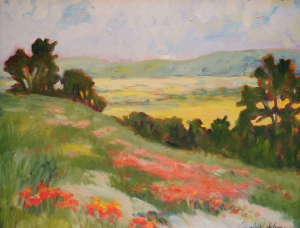My friend Cathy loaned me a book called Provence Interiors. With the weather turning cold again, I get to sit down by the fire, wrap up in my wool shawl, and turn page after page of this gorgeous book and dream.
The French are masterful artists, even in the way they live. Their interiors have a worn, carelessly thrown together look that is spontaneous, inviting and homey. The rosy-coloured plaster may be chipping and the white slipcovers a little bit loose-fitting, but in the hands of the French, the imperfections somehow add to the charm. Life slows down in these rooms. I want to walk right into them. Is it that the French have been immersed in art for so many centuries that the artistic flair has become a national birthright? Art exudes from their hands, and from every little crack and cranny of their homes and of their lives.
Once, I was an au pair girl in Paris. Browsing through Cathy’s book brings it all back with a whiff of nostalgia. That was well before cell phones and PC’s invaded our silence and strained our relationships. For me, at 18, the French devotion to art came through in the way fresh flowers bloomed on Madame’s paper-strewn desk. It was visible in the presentation of delicious food, splayed out on large platters and in the dinners which were long, and lazy. Art was everywhere in the streets of Paris: in the cafes and in the little parks and gardens, where carefully dressed people just enjoyed the sun and chatted to each other or watched passers-by or pigeons. People sauntered through Luxembourg Gardens and stopped to watch the children sail the brightly painted boats in the pond. Art was in the way the French greeted each other. Even shopping for food was a slow, daily ritual as the shoppers pulled their plaid canvas shopping bags on wheels from fromagerie, to epicerie, and to the divine-smelling boulangerie. (Oh to sink my teeth into a croissant aux amandes!)
As I look back from the vantage point of 34 years later, I don’t doubt that I am romanticizing the French experience. Nonetheless, life seemed dignified and slower in their art-permeated culture. There seemed to be time to constantly rediscover the world and to be enchanted with it. I think the French would agree with me stating that art is not necessarily something you can touch or hold. Art is a way of seeing the world. It is having a deep, appreciation and reverence for the simple things in life. It is the opposite of busyness and noisiness. It is taking the time to see that even “A mouse is miracle enough to stagger sextillions of infidels.” (Walt Whitman)
I have found that a very good way to start cultivating the art of living fully and creatively is to pick up a pencil and a sketch pad and just start slowly and silently drawing whatever surrounds you, giving it your full attention. You don’t have to be an artist. In fact, don’t even think about what your drawing will look like. The more you do this, the more staggering the simple things in life become. Life springs wide open with endless possibilities, and you, like the French, will respond with surprising creativity in all aspects of your life.
